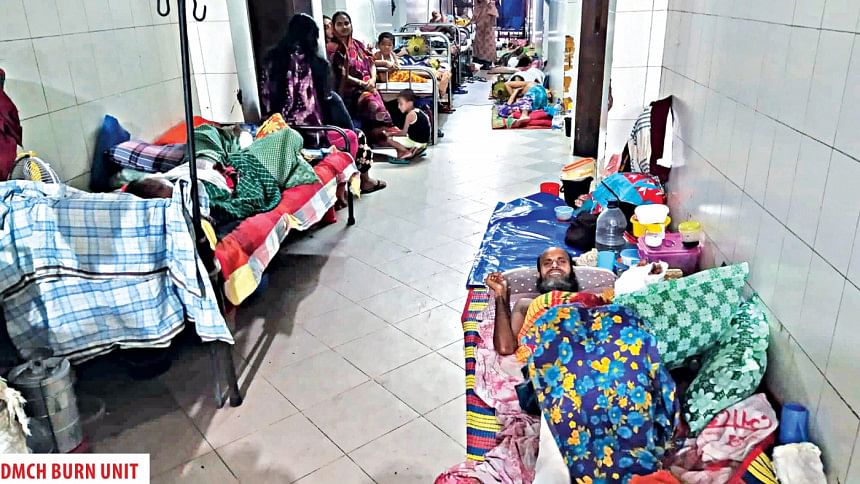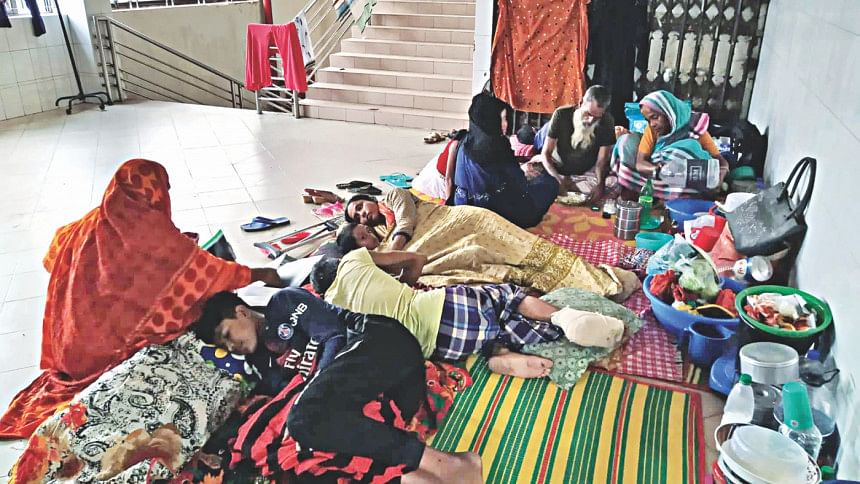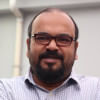A Stark Contrast: Coping with patients five times its capacity

Sitting on the floor by her son, Nurunnahar gently moves Ibrahim’s head upwards and helps him drink water.
Ibrahim flinches. The mother softly asks him if he wants to eat anything, then carefully rests his head on a mattress on the floor of the corridor of the 100-bed burn unit of Dhaka Medical College Hospital.
With 62 percent burns, Ibrahim Sarker from Satkhira Sadar had been undergoing treatment at the unit for over two months when this newspaper visited the unit.
On the night of August 15, while sleeping at his home, the 21-year-old brick kiln worker suffered injuries caused by a fire originating from an oil lamp.

He was taken to Khulna Medical College Hospital right away, where he stayed for 16 days. As his condition deteriorated, doctors referred him to DMCH.
At DMCH, Ibrahim had to stay at the burn unit’s ICU for two months. With his condition improving, he was later shifted to the corridor on the third floor.
“My son is doing better now,” said Nurunnahar. “Doctors said he needs one more surgery,” she told this newspaper.
Not only Ibrahim, but many others are also staying with their families -- either on the floor or makeshift beds -- often crammed together in the corridor or by the staircase of the third floor.
“At present, we have over 500 patients admitted here,” said AFM Nabin, resident surgeon at the burn unit. “We know it’s beyond our capacity, but we try to provide treatment to everyone who walks through our gate,” he added.
Nabin continued, “That’s why you see so many patients on the corridor.”
One such patient is Jahangir Hossain.
On September 27, the 30-year-old rickshaw-puller was having tea at a roadside stall in Lakshmipur Sadar upazila. Suddenly, a scuffle broke out. Someone kicked the frying pan next to the stall and hot oil spilled on him.
Jahangir was referred to DMCH from the district hospital. His family members admitted him to the burn unit the same day. He is now staying at the unit’s corridor. According to doctors, he needs another surgery. His brother and mother are also staying with him.
Four-year-old Sohana from Jamalpur and 14-year-old Rumi Akter of Mymensingh are also being treated at the unit, among many others.
While talking to this newspaper at the hospital, their family members expressed concerns about patients’ wellbeing. At the same time, they were worried about continuing treatment as it is already taking a heavy toll on them. Many had to borrow money, sell property or leave work to stay with their loved ones at the hospital.
A CONTINUING CRISIS
Since its inception in December 2003, the burn unit has lacked manpower, especially support staff. It has been depending mostly on irregular “staff members” who learnt everything on the job, including delicate procedures like dressing.
Around 70 such “staff members” have been providing services in exchange for tips from patients’ families.
This gap between the number of patients and hospital workers is filled by patients’ attendants. And so, the authorities’ hands remain tied in regard to limiting visitors’ movement, said hospital sources.
Meanwhile, patients like Ibrahim and Jahangir remain at the risk of contracting infections.
According to three consecutive years’ worth of data of the burn unit since 2014, the yearly death toll stood at around 12 percent of admitted patients. More lives could be saved if only the spread of infections on burn patients could be prevented, according to DMCH sources.
Acknowledging infection as the cause of death for many burn patients, Samanta Lal Sen, national coordinator of Sheikh Hasina National Institute of Burn and Plastic Surgery, said unrestricted movement of visitors inside the hospital is one of the reasons.
Patients having to use the floor space during treatment also involuntarily contributes to the spread of infections, he added.
There was a proposal of transforming the unit to a 300-bed one, but after the establishment of the new burn institute, it was not implemented, said Dr Sen.
Acknowledging the crisis, Brig Gen AKM Nasir Uddin, director of DMCH, said, “We are trying our best to provide adequate services to patients. Most patients come here with hope that they will get treatment. How can we refuse them?”
“At the same time, we’re aware that we have to control infections as well as limit visitors’ movement. We are working on that,” the director told this newspaper recently.
About treatment costs, he said, “Burn treatment is expensive. We’re planning to increase budget for medicine, among others, so that patients can get them easily.
“Once the new burn institute starts functioning properly, it will take some load off us,” the director mentioned.


 For all latest news, follow The Daily Star's Google News channel.
For all latest news, follow The Daily Star's Google News channel. 



Comments